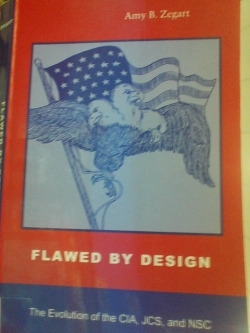Flawed by Design: The Evolution of the CIA, JCS, and NSC

Buy online ($)
Type
Book
Authors
ISBN 13
9780804741316
Category
327.12 International Relations-Intelligence
[ Browse Items ]
Publication Year
1999
Publisher
Pages
317
Subject
1. United, Central Intelligence Agency-History 2. Intelligence Service-United States 3. United States, Council (US)- History
Tags
Abstract
In this provocative and thoughtful book, Amy B. Zegart challenges the conventional belief that national security agencies work reasonably well to serve the national interest as they were designed to do. Using a new-institutionalist approach, Zehgart asks what forces shaped the initial design of the Central Intelligence Agency, the Joint Chiefs of Staff, and the National Security Council in ways that meant they were handicapped from birth.
Description
In this provocative and thoughtful book, Amy Zegart challenges the conventional belief that national security agencies work reasonably well to serve the national interest as they were designed to do. Using a new institutionalist approach, Zegart asks what forces shaped the initial design of the Central Intelligence Agency, the Joint Chiefs of Staff, and the National Security Council in ways that meant they were handicapped from birth. Ironically, she finds that much of the blame can be ascribed to cherished features of American democracy―frequent elections, the separation of powers, majority rule, political compromise―all of which constrain presidential power and give Congress little incentive to create an effective foreign policy system. At the same time, bureaucrats in rival departments had the expertise, the staying power, and the incentives to sabotage the creation of effective competitors, and this is exactly what they did. Historical evidence suggests that most political players did not consider broad national concerns when they forged the CIA, JCS, and NSC in the late 1940s. Although President Truman aimed to establish a functional foreign policy system, he was stymied by self-interested bureaucrats, legislators, and military leaders. The NSC was established by accident, as a byproduct of political compromise; Navy opposition crippled the JCS from the outset; and the CIA emerged without the statutory authority to fulfill its assigned role thanks to the Navy, War, State, and Justice departments, which fought to protect their own intelligence apparatus. Not surprisingly, the new security agencies performed poorly as they struggled to overcome their crippled evolution. Only the NSC overcame its initial handicaps as several presidents exploited loopholes in the National Security Act of 1947 to reinvent the NSC staff. The JCS, by contrast, remained mired in its ineffective design for nearly forty years―i.e., throughout the Cold War―and the CIA’s pivotal analysis branch has never recovered from its origins. In sum, the author paints an astonishing picture: the agencies Americans count on most to protect them from enemies abroad are, by design, largely incapable of doing so. - from Amzon
Biblio Notes
Table of Content:
Introduction.............................................................................................P. 1
1. Toward a Theory of National Security Agencies.........................................P. 12
2. Origins of the National Security Council System: A "Brass-Knuckle Fight to
the Finish".......................................................................................... P. 54
3. Evolution of the National Security Council System: "From King's Ministers
to Palace Guard"..................................................................................P. 76
4. Origins of the Joint Chiefs of Staff: "Fighting for the Very Life
of the Navy".......................................................................................P. 109
5. Evolution of the Joint Chief of Staff:"The Swallows Return to Capistrano"....P. 131
6. Origins of the Central Intelligency Agency: "Those Spooky Boys"...............P. 163
7. Evolution of the Central Intelligence Agency: "One of the Weakest Links
in Our National Security"......................................................................P. 185
8. Conclusion..........................................................................................P. 223
Introduction.............................................................................................P. 1
1. Toward a Theory of National Security Agencies.........................................P. 12
2. Origins of the National Security Council System: A "Brass-Knuckle Fight to
the Finish".......................................................................................... P. 54
3. Evolution of the National Security Council System: "From King's Ministers
to Palace Guard"..................................................................................P. 76
4. Origins of the Joint Chiefs of Staff: "Fighting for the Very Life
of the Navy".......................................................................................P. 109
5. Evolution of the Joint Chief of Staff:"The Swallows Return to Capistrano"....P. 131
6. Origins of the Central Intelligency Agency: "Those Spooky Boys"...............P. 163
7. Evolution of the Central Intelligence Agency: "One of the Weakest Links
in Our National Security"......................................................................P. 185
8. Conclusion..........................................................................................P. 223
Number of Copies
1
| Library | Accession No | Call No | Copy No | Edition | Location | Availability |
|---|---|---|---|---|---|---|
| Main | 152 |
327.12 ZEG |
1 | Yes |




